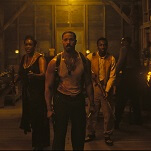Sylvester Stallone fought his career trajectory—and his own age—in Demolition Man
If you ate in a Planet Hollywood restaurant at any point after 1993, you no doubt noticed a strange-looking prop hanging from the ceiling: a nearly nude mannequin of Sylvester Stallone contorted inside a clear plastic cylinder. According to the Demolition Man Blu-ray commentary track, Stallone not only insisted that the mannequins be anatomically correct (showing his “very strong masculine side,” according to producer Joel Silver), he apparently loved the sight of himself as a butt-naked pretzel so much, he had dozens of copies of that prop made and installed in the rafters of Planet Hollywoods all over the world. Because really, who doesn’t enjoy staring at Rambo’s taint while eating a plate of sizzling fajitas?
Before these Rocky popsicles began ruining appetites on a global scale, the original one appeared in Stallone’s 1993 action film Demolition Man, where they stood in for the actor when his character was cryogenically frozen as punishment for a crime he didn’t commit. In the minds of the public at large, Demolition Man is little more than a footnote in Stallone’s career, a movie remembered—when it’s remembered at all—as another in a long line of mediocre pictures Stallone made throughout the ’90s as he struggled to reconnect with audiences after the (temporarily) final Rambo and Rocky sequels. In fact, Demolition Man is a good deal more than that. Besides being a superb action movie and a clever satire of cop and science-fiction movies, it’s also a surprisingly autobiographical statement from Stallone about his life and career. And it’s all summed up by that image of Stallone encased in ice.
Stallone plays John Spartan, a rough-and-tumble ’90s Los Angeles police officer Rip Van Winkled into the year 2032 via a sentence in an experimental “Cryo-Prison.” After decades in forced cryogenic slumber, Spartan awakens in “San Angeles,” which has been radically reshaped as a brave new world in the wake of a cataclysmic earthquake. In San Angeles, everything that’s “bad” for you—sex, kissing, profanity, guns, red meat, salt, etc.—is illegal. The populace is polite, wimpy, and constantly monitored by subdermal microchips. Crime is nonexistent. That’s why the San Angeles Police Department needs Spartan (a.k.a. “The Demolition Man”) to help them recapture the man who framed him for murder back in the 20th century, psychopathic gangster Simon Phoenix (Wesley Snipes), after he escapes from the Cryo-Prison and embarks on a “MurderDeathKill” spree.
As the story of two men from one era awakening in another where they’re severely out of place, Demolition Man was conceived as a movie about relics. Now it’s something of a relic itself, harkening back to a simpler, arguably better time in action-film history when directors favored clarity over freneticism. In 2012, Demolition Man looks dated in a pleasing, they-don’t-make-them-like-they-used-to sort of way. The special effects are decidedly analog, and the way the film frequently pauses between action beats to make room for character, romance, and philosophical questions about society also makes it clear that it belongs to a different filmmaking era.
The movie was one of only two mainstream directorial efforts by Marco Brambilla, a video artist by trade whose work has been shown at museums around the world. (His other commercial film was the Alicia Silverstone vehicle Excess Baggage.) Brambilla’s recent piece Evolution (Megaplex) just screened in the New Frontier gallery at the Sundance Film Festival; The Village Voice’s Sundance blog quoted him as saying it was a “comment on the idea of film having become such a spectacle.” He could have just as easily been describing Demolition Man, which is both a testosterone-drenched dudefest and a quietly sarcastic spoof of the sheer ridiculousness of testosterone-drenched dudefests. It opens with the staggeringly impressive, staggeringly idiotic image of a man bungee-jumping from a helicopter while firing a machine gun, and only gets more hilariously absurd from there. Most of the film is played straight, but nearly everything functions as parody hiding in plain sight. Take the scene where Spartan is taken out to dinner at an ultra-upscale Taco Bell as a thank-you from the grateful head of San Angeles, Dr. Cocteau (Nigel Hawthorne). The product placement is so shameless, it also functions as its own joke about shameless product placement. (On a side note: In the future of Demolition Man, Taco Bell is the only restaurant in the world, having crushed its competition in something called “the franchise wars.” Truly, this is the face of dystopia.)
Spartan’s partner in 2032 is SAPD Officer Lenina Huxley (a pre-stardom Sandra Bullock, playing a character whose name contains two references to the dystopian science-fiction novel Brave New World). Huxley is bored by the uneventful life of a policewoman in a utopia, and excited by the prospect of teaming up with a legendary supercop like the Demolition Man. “What I wouldn’t give for some action!” Huxley moans on one beautiful, boring San Angeles morning. Cut to Phoenix at his Cryo-Prison parole hearing; he quickly obliges her request.








































